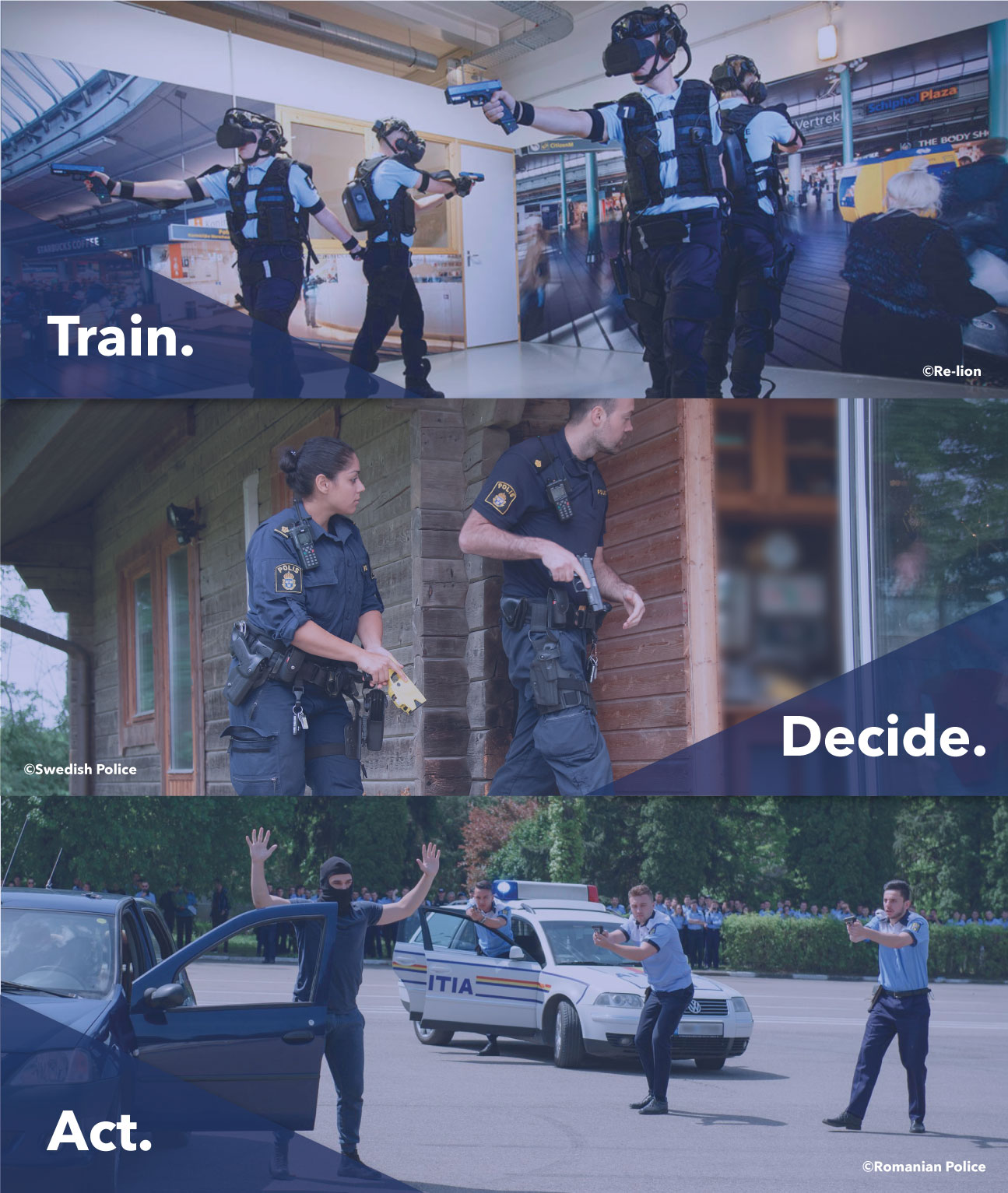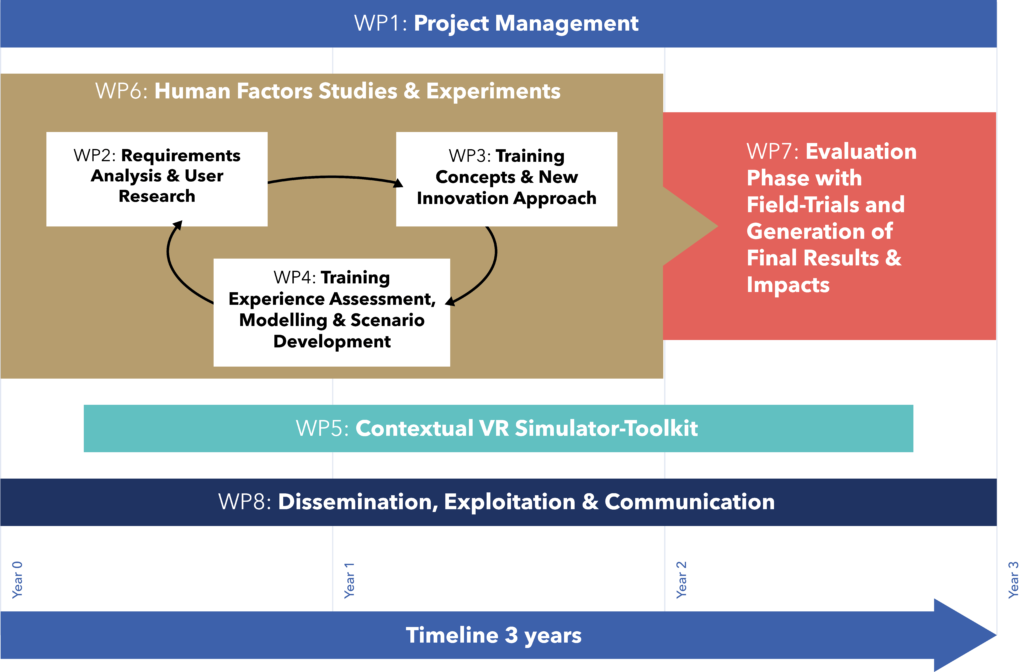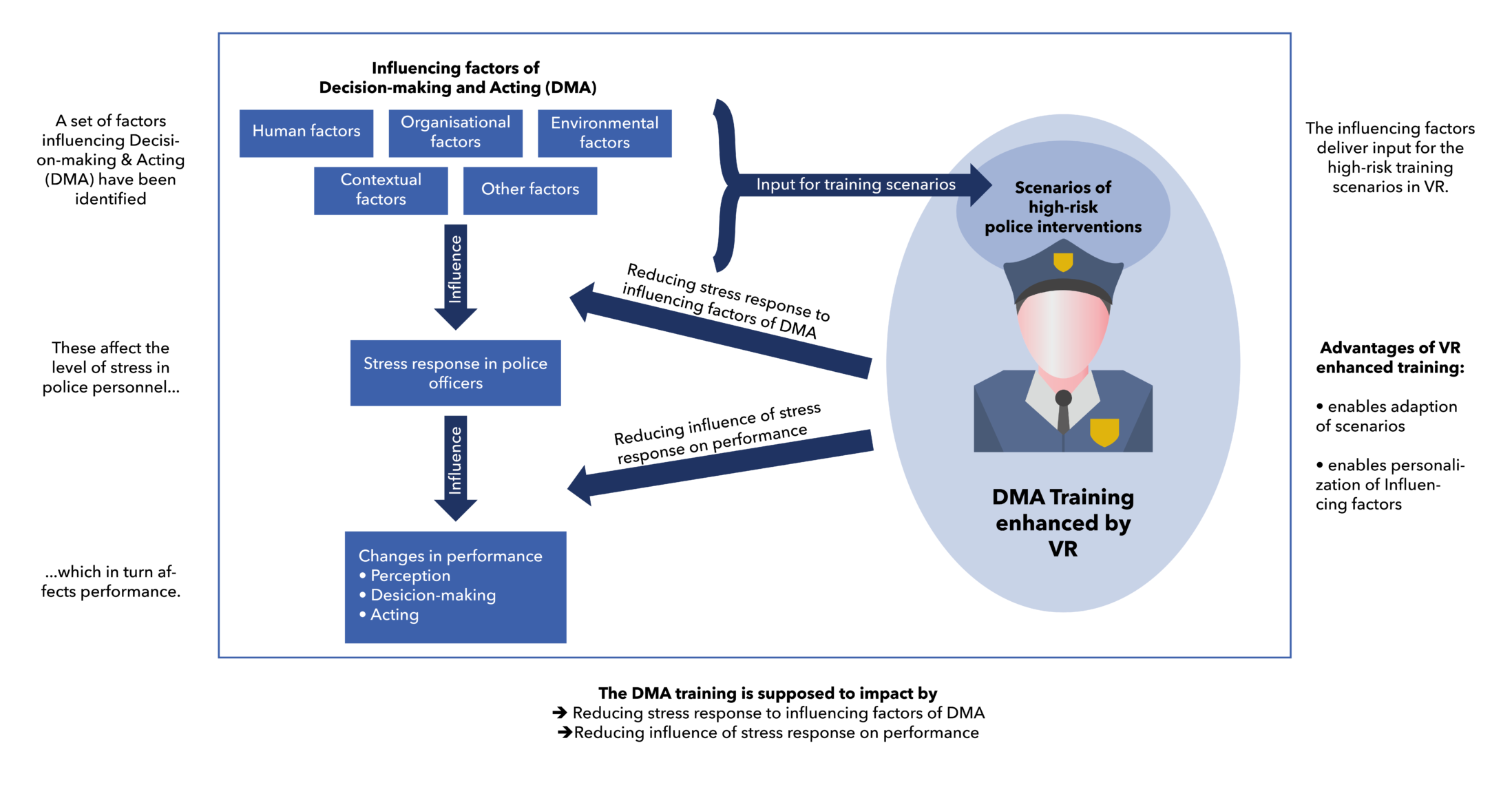About Shotpros
The SHOTPROS project
The European street patrol police officer’s field of action is in a constant state of change and new challenges are emerging all the time. The number of incidents where police officers are first responders in critical situations with severe threat circumstances has drastically increased. Being the first responder in high-risk situations never faced before, creates a highly stressful situation.
The SHOTPROS project aims to investigate the influence of psychological and contextual human factors (HFs) on the behaviour of decision-making and acting (DMA) of police officers under stress and in high-risk operational situations in order to design better training for police officers to improve DMA Performance. SHOTPROS will develop a Virtual Reality (VR) solution to experimentally assess the degree to which these factors influence DMA behaviour.
What we do
Subsequently the project will develop a HF-rooted training curriculum and a corresponding VR training solution to provide a comprehensive framework for practical training for decision-making and acting under stress and in high-risk (DMA-SR) situations in order to improve performance.The training will increase DMA-SR performance which will lead to better and more correct decisions (from several perspectives, e.g. law, ethic, etc.), to keep the guidance in threatened situations, to minimise use of force occurrences, and accordingly, to maximise the avoidance of casualties and collateral damage, such as panic and cascading or escalating effects.

Existing trainings mainly focus on skill training and do leave out the decision-making and acting behavior training. We aim to set up a training framework, enhanced with Virtual Reality, to change the training methods in LEAs to come to better decisions and minimizing use of forces, collateral damages and escalations.
Objectives of SHOTPROS
For SHOTPROS, we identified 5 distinctive and forward-looking objectives. All objectives will strongly support the idea of the European Security Model and supports the internal security strategy for the European Union.

Learn more about the objectives and the expected outcomes of SHOTPROS:
One of the main goals of SHOTPROS is to quantify the influence of several human factors (i.e., contextual factors, psychological factors, etc.) on the decision-making and acting process under stress and in high-risk situations, controlling for the possible influence of organizational and environmental factors.
Based on these results, the project will develop a conceptual model of DMA in such situations, including the above-mentioned factors that influence perception, decision-making, behaviour and action in a potentially threatening situation for police forces. Additionally, risk-assessment as part of the decision-making process will be tackled. Furthermore, the conceptual model will be validated by testing the various premises of the model in research experiments and will then be further evaluated and refined.
The SHOTPROS project will develop a VR Training Framework that is able to dynamically introduce psychological (e.g. anxiety inducing) and physiological cues into virtual training scenarios. Throughout this development a large range of cues will be scientifically assessed, and after a pre-selection validated, for their ability to induce certain emotions and to train appropriate behaviour during VR training sessions.
This scientific validation will also consider the influence of situational and dispositional factors, e.g., socio-demographic characteristics (e.g., gender, age, ethnicity, etc.), personality (e.g., the Big Five), interactions (e.g., suspect resistance, dynamics between police officers and other first responders, presence of other people at the scene, etc.), and contextual factors (e.g., noise, smell, characteristics of the scene, other involved people in the scenario, etc.) on the cues’ emotion inducement abilities. Based on this research a repository of properly working (or inducing, respectively) cues will be constructed.
In an initial step, a comprehensive overview of existing decision-making trainings in law enforcement agencies across Europe and best practices for effective training of police forces for optimal decision making in real life situations will be gathered. A comparative analysis will show the common baseline, minimum mandatory (legally imposed) elements, strong aspects and shortcomings, as well as innovative approaches.
Building upon the identification of these best practices and utilizing the abilities of the evidence-based model of human decision-making (Objective 1) and the VR environment (Objective 2), the project will propose an innovative training program, using real-world training enhanced with VR training, for optimizing decision-making and acting in high-stress situations.
SHOTPROS aims to make the gained knowledge about VR trainings available for the future development and setup of training systems using VR technologies. For this purpose, it compiles all the created knowledge in several guidelines that can serve as a basis for the integration of VR training tools in European Law Enforcement Agencies (LEAs) existing training practices. With these guidelines that are based on findings of the requirements analysis and evaluations with end-users, SHOTPROS contributes to the efforts towards a harmonized and standardised European police training framework. The created guidelines support the European Security Model for enhancing the topic of “innovation and training” and standardisation of (training) frameworks within the European police forces and organisations.
SHOTPROS will establish a “VR Police Training Network” which will include the LEAs from SHOTPROS and reach out to other interested LEAs from the European Union (and EU partner countries) which are not part of the consortium project team Preparatory research, interviews and workshops with the European LEAs during the preparation of the proposal showed a lack of strategy and knowledge of VR Training in the fight against radicalization in crime and terrorism for Police forces.
Elements and Structure of Workpackages
The work plan of SHOTPROS is divided into 9 distinct work packages, altogether lasting 36 months. Since the work is highly collaborative, several partners will be involved in each of the work packages.

Learn more about the work packages of SHOTPROS:
This work package aims to ensure the successful execution and completion of the project and to manage the project in a target-focused manner. The project coordinator ensures that all deliverables are submitted in time, milestones are met, and risks are minimized.
The first operational work package, WP2, focuses on analysing and uncover the requirements from different stakeholders involved in police trainings (e.g. trainer, trainee, academy leads, etc.) and several perspectives (e.g. organisational, cultural, societal, etc.). It will also investigate the societal impact of police DMA on citizens’ perspectives on police legitimacy and trust and will help at incorporating the needs of EU citizens in the project as well.
In WP3 a conceptual model of behaviour, including different contextual and human factors that influence perception, decision-making and acting in a potentially threatening situation will be created. WP3 will prepare a research agenda to validate (in WP6) the DMA-SR model and create the needed training concepts, methods and tools.
Work in WP2-3 will be performed in parallel and will serve as input to WP4. The main objectives of WP4 are creation and validation of a psychological and physiological cue repository, prototyping the VR scenarios and the performance dashboard for trainers (WP5, WP7), develop a psychophysiological measurement suite and define the technical requirements for the VR Simulator Toolkit (for WP5). Furthermore, a risk assessment toolkit to identify high-risk situations will be developed.
The objective of WP5 is to provide and develop the necessary VR infrastructure, VR technical knowledge and software components for conducting the human factors studies (WP6) and the end user field-trials (WP7).
The main objective of WP6 is the preparation (planning, measurement tools etc.) and execution of the human factor experiments and studies that have to be carried out in accordance with the research questions addressed in WP2-4. To achieve maximal ecological validity, these studies and experiments will be executed at the premises of the LEAs and recruiting test subjects among them.
The results from the previous WPs will now be evaluated and improved from direct feedback of the LEAs (within the consortium and external LEAs). The results from WP 2-6 will be evaluated in field-trials at the different LEAs (on-site) and at the final SHOTPROS conference
The coordinator and WP8 leader USE will organise together with all partners the communication with external stakeholders as part of dissemination activities. Such communication will be facilitated through the website (e.g. www.shotpros.eu) and the various dissemination activities as described in the impact section.
Ethical guidelines and procedures will be established and prepared for all consortium members to adhere to during the entire research and development and testing of the SHOTPROS System. These ethical guidelines will focus on related consent and confidentiality procedures of the end users of the system as well as the protection of any collected data.
The task leader will monitor all activities within the project to make sure that they follow the ethical guidelines and procedures.
Methodology & Goals
SHOTPROS will adopt a strong human and stakeholder centred research approach building on the psychology, criminology, Human Computer Technology and VR Technology expertise within the consortium. As an integral basis of the project, USE and AIT with their strong background on user-centred-design as well as KUL with their expertise in requirements for criminology contexts, will collect user requirements from the LEA stakeholders (e.g. trainees, trainer, police academy leads, decision-makers for training programs, etc) on several perspectives (e.g. ethic, gender, safety, legal, privacy, business, etc.).
End-User in the centre of research
In this process the LEA’s rich practical knowledge on (potentially) high risk situations and resulting decisions from their officers together with VESTA’s strong background in police training facilities and processes will be transferred into definitions and requirements for the streamlined scenario building process in the later stages of the project. With respect to DMA models VUA will utilize their outstanding knowledge and overview on existing modelling approaches and together with KUL and their expertise on human factors in criminology they will derive the innovative conceptual model of DMA behaviour including different contextual and human factors that influence perception, decision-making and acting in potentially threatening situations close collaboration with personnel from all participating LEA’s.

